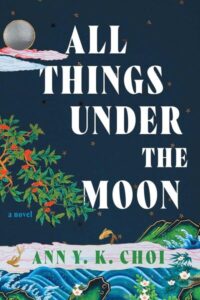Ann YK Choi made a splash on the literary scene a decade ago with her debut novel, Kay’s Lucky Coin Variety, a coming of age story of a young Korean-Canadian who grew up in her family’s convenience store in 1980s Toronto. This book was a finalist for the Toronto Book Awards, among many accolades. With her new novel, All Things Under the Moon, Choi effortlessly switches genres from contemporary to historical fiction.

Setting the story in the 1920s when Korea was occupied by Japan, Choi writes of strong female friendships that endure above all others. Na-Young lives in a village with her mother, brother, father, and her father’s second wife and their children. It’s not a happy household and ever since Na-Young’s sister passed away from an infectious disease, her branch of the family has been degraded in favor of the second wife and her children. Yet Na-Young can’t complain, for her best friend Yeon-Soo has suffered more after becoming a young widow.
When Na-Young’s father arranges a marriage for her with the son of an old classmate closer to Seoul, Na-Young panics because she doesn’t want to leave Yeon-Soo or her mother. In one of Choi’s references to time and place, Na-Young’s zodiac sign is a poor match with that of her husband-to-be.
To Mother’s disappointment, the boy Father had chosen for Na-Young was only two years her senior, born in the year 1905, making him a Wood Snake. Na-Young’s ideal companion would have been a Water Rabbit, a good match for a Fire Goat.
Na-Young and Yeon-Soo run away from home, but shortly come face to face with Japanese soldiers and need to separate to avoid arrest by the Japanese police. Yeon-Soo heads for the capital city and Na-Young returns home. Her wedding takes place as planned.
As it turns out, Na-Young’s father-in-law is much more welcoming and teaches her to read and write not just Korean, but Japanese, Chinese, and English.
Na-Young gazed around at all the books. Could it be possible that one day she would be able to pick up any book and read it? She imagined her fingers flipping through the pages. Could she learn history?
The marriage is not a happy one and her husband pays her little to no attention, but the two reach a truce. Na-Young, resembling her husband’s late mother, continues to learn from her father-in-law; she starts to wonder if he brought her into the family more for himself than for his son.
Na-Young leaves home once more, this time in search of Yeon-Soo in the capital. She finds work in a teahouse. Choi’s descriptions also carry the story and the teahouse is one of the most vivid settings in the book.
With its classic tile and wood details, there was nothing remarkable about its exterior. It wasn’t until patrons passed through the main entrance, where they slipped off their shoes before entering through the flower-decorated doors, that they felt a sense of arriving somewhere. Five seascape brush paintings hung side by side on the east wall, and if patrons glanced quickly from left to right, the waves moved in a circular motion. Large silk cushions, the colour of lapis lazuli, made for comfortable seating on the floor around the twelve rectangular wooden tables spread throughout the room.
Weaving in history in a way that seems natural to the story, Choi writes about Korean resistance against the ruling Japanese, a resistance that was often found in Korean Christian churches.
In her author’s note, Choi writes that the genesis of this book was truly a family affair. Na-Young was inspired by her great-grandmother who couldn’t read or write and came of age in the mid-1920s. But it wasn’t until Choi was a year shy of her 50th birthday that she learned about Korean history when her own daughter was in an Asian Studies program in university. Choi read all of her daughter’s assigned readings about China, Japan, and Korea and the two also traveled to South Korea to visit the many places Choi writes about in her book, from the family village to Seoul. These efforts certainly paid off.


You must be logged in to post a comment.